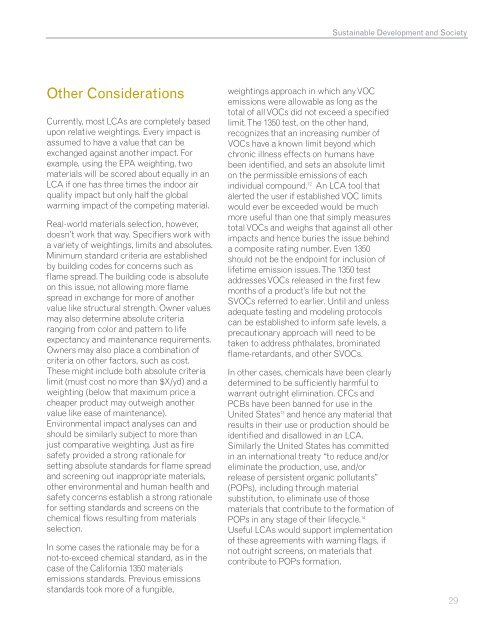Sustainable Development and Society - GSA
Sustainable Development and Society - GSA
Sustainable Development and Society - GSA
You also want an ePaper? Increase the reach of your titles
YUMPU automatically turns print PDFs into web optimized ePapers that Google loves.
<strong>Sustainable</strong> <strong>Development</strong> <strong>and</strong> <strong>Society</strong><br />
Other Considerations<br />
Currently, most LCAs are completely based<br />
upon relative weightings. Every impact is<br />
assumed to have a value that can be<br />
exchanged against another impact. For<br />
example, using the EPA weighting, two<br />
materials will be scored about equally in an<br />
LCA if one has three times the indoor air<br />
quality impact but only half the global<br />
warming impact of the competing material.<br />
Real-world materials selection, however,<br />
doesn’t work that way. Specifiers work with<br />
a variety of weightings, limits <strong>and</strong> absolutes.<br />
Minimum st<strong>and</strong>ard criteria are established<br />
by building codes for concerns such as<br />
flame spread. The building code is absolute<br />
on this issue, not allowing more flame<br />
spread in exchange for more of another<br />
value like structural strength. Owner values<br />
may also determine absolute criteria<br />
ranging from color <strong>and</strong> pattern to life<br />
expectancy <strong>and</strong> maintenance requirements.<br />
Owners may also place a combination of<br />
criteria on other factors, such as cost.<br />
These might include both absolute criteria<br />
limit (must cost no more than $X/yd) <strong>and</strong> a<br />
weighting (below that maximum price a<br />
cheaper product may outweigh another<br />
value like ease of maintenance).<br />
Environmental impact analyses can <strong>and</strong><br />
should be similarly subject to more than<br />
just comparative weighting. Just as fire<br />
safety provided a strong rationale for<br />
setting absolute st<strong>and</strong>ards for flame spread<br />
<strong>and</strong> screening out inappropriate materials,<br />
other environmental <strong>and</strong> human health <strong>and</strong><br />
safety concerns establish a strong rationale<br />
for setting st<strong>and</strong>ards <strong>and</strong> screens on the<br />
chemical flows resulting from materials<br />
selection.<br />
In some cases the rationale may be for a<br />
not-to-exceed chemical st<strong>and</strong>ard, as in the<br />
case of the California 1350 materials<br />
emissions st<strong>and</strong>ards. Previous emissions<br />
st<strong>and</strong>ards took more of a fungible,<br />
weightings approach in which any VOC<br />
emissions were allowable as long as the<br />
total of all VOCs did not exceed a specified<br />
limit. The 1350 test, on the other h<strong>and</strong>,<br />
recognizes that an increasing number of<br />
VOCs have a known limit beyond which<br />
chronic illness effects on humans have<br />
been identified, <strong>and</strong> sets an absolute limit<br />
on the permissible emissions of each<br />
individual compound. 12 An LCA tool that<br />
alerted the user if established VOC limits<br />
would ever be exceeded would be much<br />
more useful than one that simply measures<br />
total VOCs <strong>and</strong> weighs that against all other<br />
impacts <strong>and</strong> hence buries the issue behind<br />
a composite rating number. Even 1350<br />
should not be the endpoint for inclusion of<br />
lifetime emission issues. The 1350 test<br />
addresses VOCs released in the first few<br />
months of a product’s life but not the<br />
SVOCs referred to earlier. Until <strong>and</strong> unless<br />
adequate testing <strong>and</strong> modeling protocols<br />
can be established to inform safe levels, a<br />
precautionary approach will need to be<br />
taken to address phthalates, brominated<br />
flame-retardants, <strong>and</strong> other SVOCs.<br />
In other cases, chemicals have been clearly<br />
determined to be sufficiently harmful to<br />
warrant outright elimination. CFCs <strong>and</strong><br />
PCBs have been banned for use in the<br />
United States 13 <strong>and</strong> hence any material that<br />
results in their use or production should be<br />
identified <strong>and</strong> disallowed in an LCA.<br />
Similarly the United States has committed<br />
in an international treaty “to reduce <strong>and</strong>/or<br />
eliminate the production, use, <strong>and</strong>/or<br />
release of persistent organic pollutants”<br />
(POPs), including through material<br />
substitution, to eliminate use of those<br />
materials that contribute to the formation of<br />
POPs in any stage of their lifecycle. 14<br />
Useful LCAs would support implementation<br />
of these agreements with warning flags, if<br />
not outright screens, on materials that<br />
contribute to POPs formation.<br />
29

















